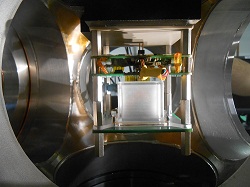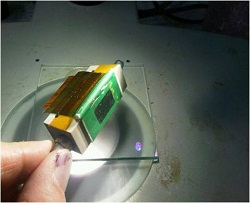Prof John Stark
BSc(Exon) MSc(Man) PhD(Lond) FRAS FRAeS
Research Overview
The principal linking theme in my research group is electrohydrodynamics. Whilst this was initiated through experimental studies in gas, plasma and fluid physics this approach is now focused directly in applying this knowledge into two principal application areas. The two applications are spacecraft electric propulsion and high resolution electrostatic printing.
Spececraft electric propulsion is seen now as an enabler to many opportunities hitherto unachievable. In particular small satellites, such as CubeSats have insufficient resources in both electrical power availability and physical volume to utilise the benefits of electric propulsion: the highly efficient compact electrospray colloid propulsion being developed in my group can overcome both these obstacles.
High resolution printing of functional materials, such as those used in electronic devices including OLED screens and touch screens is again a potentially disruptive technology in high value additive manufacturing. Electrostatic printing offers a versatile approach which enables "inks" having an exceptionally broad range of physical characteristics including viscosity and conductivity
Current Research Topics
Spacecraft electrostatic micro propulsion using an integrated micro-fabricated technology approach.
 |
|
Breadboard model colloid thruster under test |
Three projects are currently funded: Horizon 2020 HiperLoc-EP - High performance low cost electric propulsion system development http://www.hiperloc.eu/; European Space Agency ESA Contract No. 4000117147/16/NL/PS; Airbus Defence and Space contract. Total projects value £1.7m.
Collaborators on these projects are Airbus Defence & Space Ltd, NanoSpace AB (Sweden) and SystematIC Designs (Netherlands).
These coordinated projects are developing a disruptive technology to space vehicle electric propulsion. Whilst this technology is appropriate to small satellites, its low cost approach makes it highly relevant to larger satellite systems and satellite constellations.
High Resolution Electrostatic Printing
 |
|
Prototype 2000 dpi printhead |
Two projects are currently funded:
Horizon 2020: Hi-Response : http://hi-responseh2020.eu/ and Innovate UK/EPSRC : Hi Prospects http://www.hiprospects.com/about.html . These projects have substantial industrial partnerships across Europe and the UK including: PVi Ltd, Fraunhofer IAP, Interuniversitair Micro-Electronica Centrum VZW (IMEC), TNO, Ficosa, Orbotech, Zytronic Ltd, Intrinsic Ltd, University of Swansea, University College London. Total project value £9m.
The use of electrospray as a direct writing/digital fabrication technique for surface functionalization in devices such as flat screen displays, photovoltaic systems and printing electronic circuits, encapsulation for drug delivery and the manufacturing of tissue engineering scaffold structures, improved analyte transfer efficiency in mass spectrometry. The process underlying the digital fabrication capability is via a controlled operation of electrospray pulsations. This approach is covered by European granted patents: EP1963024B1 and EP2162228B1.
Previous Funded Research Topics
- Spacecraft Environmental Effects: development of orbital velocity atomic oxygen simulation facility; on-board atomic oxygen monitor; theoretical plume impingement studies.
- Development of Direct Simulation Monte Carlo Method methodology for rarefied reacting gas dynamics and space debris applications.
- Spacecraft Propulsion: electric propulsion mission analysis; arc-jet stability and erosion studies; micro-injector chemical propulsion studies

